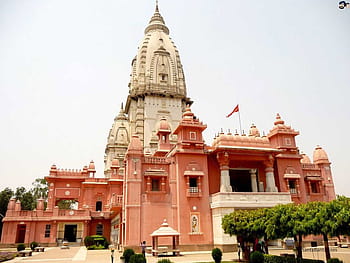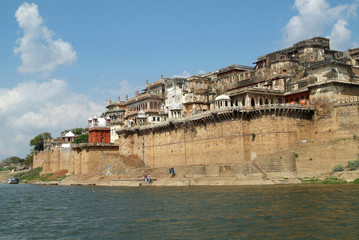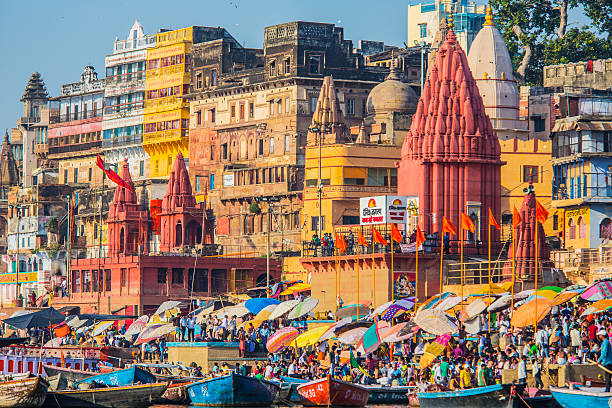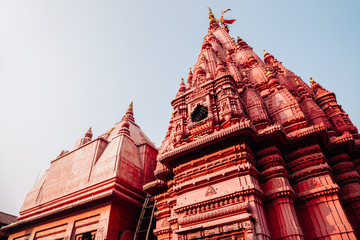- Private car and driver in Delhi / India
- +91-8447445445
- info@discoverindiabycar.com sugar.ankit@yahoo.com
 +91-9818434712
+91-9818434712
Varanasi
The state of Uttar Pradesh in northern India contains the city of Varanasi, which was founded in the 11th century B.C. The city, which is regarded as India’s spiritual capital, attracts Hindu pilgrims who take holy baths in the Ganges River and carry out death ceremonies. There are almost 2,000 temples in the city, including Kashi Vishwanath, the “Golden Temple,” which is devoted to the Hindu god Shiva.
Climate
With significant temperature differences between summer and winter, Varanasi has a humid subtropical climate. The monsoon season, which runs from July to October, follows the dry summer, which begins in April and lasts until June. In the summer, the temperature ranges from 22 to 46 °C (72 to 115 °F). Varanasi experiences very significant diurnal fluctuations during the winter, with warm days and extremely chilly nights. In the winter months of December through February, cold waves from the Himalayan region cause temperatures to drop across the city, and lows of 5 °C (41 °F) are not unusual. 1,110 mm of rain falls annually on average (44 in). Winters are frequently foggy, but summers are hot and dry with strong breezes.
Location
Varanasi is situated along the left crescent-shaped bank of the Ganges, between 15 metres (50 feet) and 21 metres (70 feet) above the river, in the eastern portion of the state of Uttar Pradesh, at a height of 80.71 metres (264.8 feet), in the middle of the Ganges valley of North India.
History of Varanasi
According to Hindu mythology, Shiva, one of the three main gods along with Brahma and Vishnu, built Varanasi. Brahma and Shiva engaged in combat, and Shiva tore off one of Brahma’s five heads. Shiva killed Brahma because he was a Brahmin, which constituted a Brhmanahatya; as a result, the head of the victim adhered to Shiva’s palm. He made an attempt to take the head off, but failed. He eventually arrived in Varanasi in this manner after spending aeons travelling the globe, at which point the hanging head of Brahma fell from Shiva’s fingers and vanished beneath the earth. Therefore, Varanasi is regarded as a very sacred location.
According to legend, the Pandavas, the main characters of the Hindu epic Mahabharata, went in quest of Shiva in order to atone for the fratricide and Brhmanahatya sins they had done during the decisive Kurukshetra War. It is regarded as one of the seven sacred towns (Sapta Puri) that can grant Moksha; the other six are Ayodhya, Mathura, Haridwar, Kashi, Kanchi, Avanti, and Dvrak. The Hastinapur king Vichitravirya married the Kashi princesses Ambika and Ambalika, from whom Pandu and Dhritarashtra were born. The union of Bhima, a son of Pandu, and Valandhara, a princess of Kashi, produced Sarvaga, who went on to rule Kashi.Duryodhana, the eldest son of Dhritarasthra, also wed the Kashi princess Bhanumati, who later gave birth to Lakshman Kumara and Lakshmanaa for him. Buddhism’s Cakkavatti Shanda Sutta book advances the belief that Varanasi will someday turn into the legendary kingdom of Ketumati during Maitreya’s reign.
How to Travel Varanasi?
You can go to Varanasi Tour by car with driver from Delhi. Discover India By Car offers the best tour packages for Varanasi. Some of the best tour packages for Varanasi with private car and driver is Heart of India and Golden Triangle with Varanasi explore India with Discover India by car.
Places to Visit in Varanasi
Shri Kashi Vishwanath Temple
Famous Hindu temple for Lord Shiva is the Kashi Vishwanath Temple. It is situated in Varanasi, Uttar Pradesh, India’s Vishwanath Gali. One of the twelve Jyotirlingas, the holiest of Shiva temples, the temple is located on the western bank of the sacred Ganges.


Ramnagar Fort
In Ramnagar, Varanasi, India, there is a fortress known as the Ramnagar Fort. It is situated on the eastern side of the Ganges, across from the Tulsi Ghat. Kashi Naresh Maharaja Balwant Singh erected the sandstone monument in the Rajputana architectural style in 1750.
Dashashwamedh Ghat
A significant ghat in Varanasi, Uttar Pradesh, on the Ganga River is called Dashashwamedh Ghat. It is close to the Vishwanath Temple and is arguably the most impressive ghat in the area. It is mentioned in two Hindu myths: in one, Brahma is said to have built it to welcome Shiva, and in the other, Brahma offered ten horses as sacrifices during the Dasa-Ashwamedha yajna that was performed here.


Shri Durga Temple
Bengali Maharani Rani Bhabani of Natore built the Durga Mandir in the 18th century. The goddess Durga is honoured in this temple. A kund (pond) that was once joined to the Ganges is located next to the temple. It is thought that the goddess’ current image did not originate from a man but rather manifested itself in the temple on its own.








